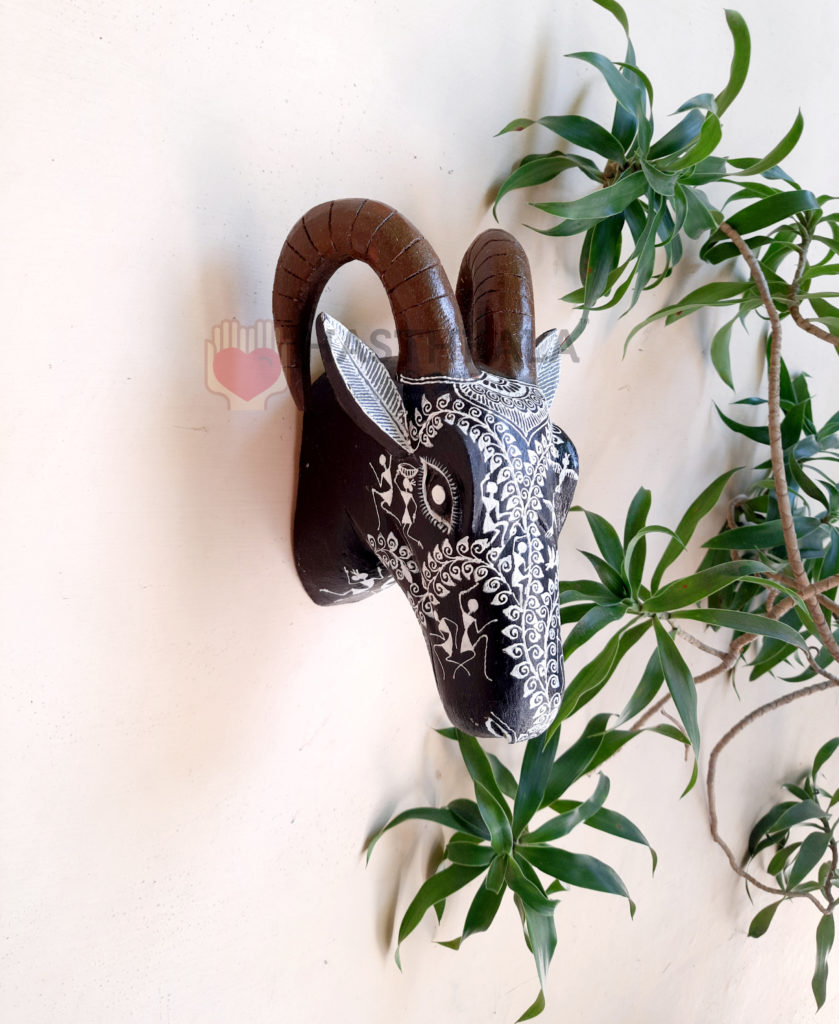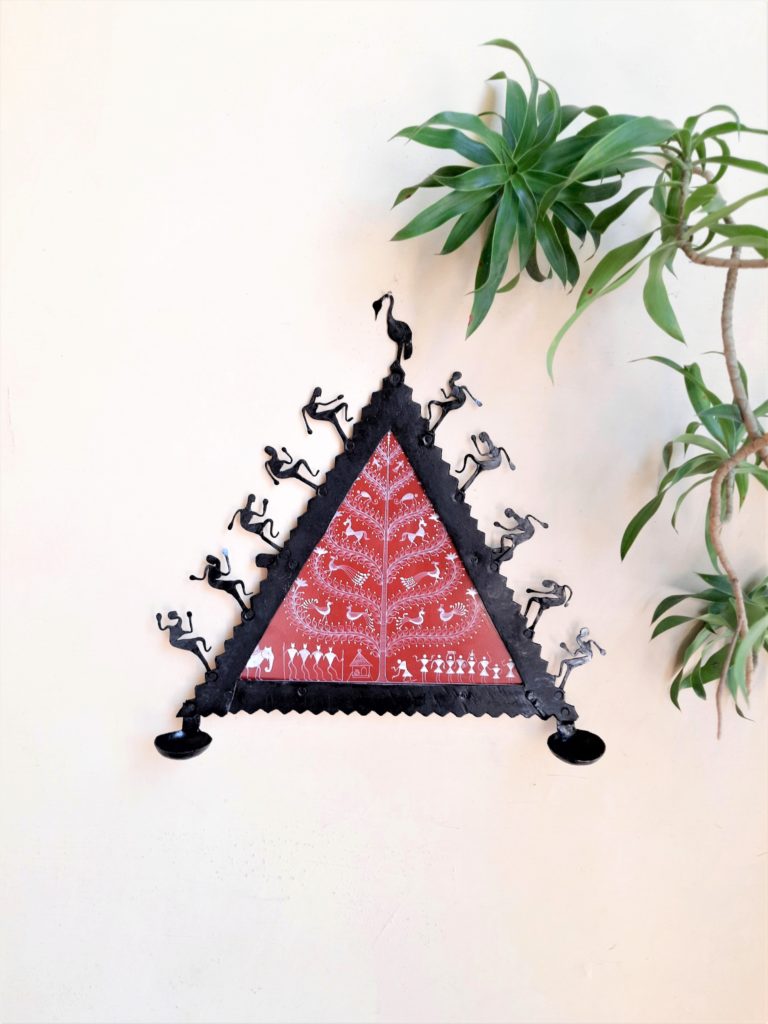Enchanting warli wall painting – Western India’s art form that cherishes nature
Dating back to the 10th century A.D, Warli traces its roots to the region of North Sahyadri Range, in Western India. This range encompasses cities such as, Talasari, Dahanu ,Jawhar, , Mokhada, Vikramgad and Palghar of Palghar district. This tribal art which originated in Maharashtra, is still practised today. Warli happens to be the largest tribe found in the northern outskirts of Mumbai. Though it in extremely close proximity to the modern city of Mumbai, the tribal completely shun even a spec of modern urbanization.
Explore handmade interior decor products inspired by Warli art form.
This is a very rustic form of warli wall painting and uses simple geometric shapes to depict their belief system and traditions. The Warli culture is centred around the concept of Mother Nature and elements of mother nature are often the focal points depicted in Warli paintings. Farming is their main means of life and a great source of food for the tribe. They deeply respect nature and wildlife for the assets they provide for life. Since the tribes are surrounded by nature and wildlife, their paintings seem to capture the true essence of it.

The paintings are monosyllabic with each structure having some social and deep significance. The circle in the paintings depict the moon and the sun, the triangle indicates mountains and conical trees. However, the square seems to follow a different logic, seeming to be a human invention, indicates a piece of land or a sacred enclosed space. The central motif in each ritualistic painting is the square, popularly known as the “chauk”, is primarily of two types: Lagnachauk and Devchauk. Enclosed within the Devchauk is the goddess of fertility, Palaghata.
Male gods are an uncommon sight among the Warli and are often related to spirits which have taken the human form. The central motif in these ritualistic paintings is surrounded by snippets depicting various activities such as hunting, farming, fishing, festivals and animals. Animal and human bodies are exemplified by two triangles joined at the tip, where the upper triangle denotes the trunk, and the lower one depicts the pelvis.
Their perilous equilibrium symbolises the poise and steadiness of the universe and has the concrete and witty lead of animating the bodies.

Warli has an appealing and vast range of themes. Not only does this art form depict ritualistic paintings, but it also portrays other warli paintings denoting day-to-day activities of the village folks. One of the dominant striking aspect of many warli paintings, is the “Tarpa dance”- the tarpa is a trumpet like instrument which is played in turns by different men. The tribal folks entwine their hands and move in the form of a circle around the tarpa player. The dancers follow the lead of the tarpa player, moving and turning as he does, never turning their back to the tarpa. The circular formation of the dancers is also said to bear a resemblance to the circle of life, with no beginning or end.
The painting is done against an austere background which is basically be a mixture of mud and cow dung cakes, but in the recent times, paint has replaced the mud. Rice, in the traditional art is life food for the soul of the art form. The white pigment using which the artists work their wonders is a paste of rice and gum. Occasional dots of red and yellow are also seen. A bamboo stick which is chewed at the end, is used to give it the texture of a paintbrush. Walls are painted only to demarcate special occasions such as festivals, weddings or harvests. This abstemiousness is counterbalanced by the joviality of their content. These paintings also seem to serve social and religious ambitions of the locals. It is held that these paintings invoke powers of the Gods.
A rare sight to behold in Warli paintings is the occurrence of straight lines. Lines are denoted using a series of dots and dashes. But in the recent times, the Warli artists have started drawing straight lines. In the earlier times, only women depicted Warli paintings on the walls. But off late, even men have taken to painting and they have started incorporating present day elements such as car, buildings, computers, space crafts, bicycles and trains, apart from traditional motifs.
Warli paintings off late are being done on paper and are sold all across the world, not just in India. Currently, tiny paintings are done on cloth and paper but they look absolutely gorgeous on the walls or in the form of huge murals that emancipates the vast and enchanted world of the tribal. For the tribals, tradition is still observed, but at the same time, new and modern depictions have been given the liberty to seep in and prepare them to face the modern day market and the niche buyers look for.
Warli art was traditionally done in white, against a brown or red mud base, in simple geometrical shapes. It has progressively diversified into various backgrounds with modern means to preserve the paintings. From walls and mud floors, the Adivasis have advanced onto paper and canvas in order to cater to the market for ornamental art, which is exceedingly commercialised.
Apart from wedding ceremonies, the warli paintings depict the stories kansara chi puja and ayichi puja, which depict and narrate specific and special occasions. Apart from these, there are depictions of poverty, the pain and sufferings of human beings and animals, which was markedly experienced during the times of droughts, floods, and other catastrophic situations.

Today, warli artists are augmenting their palette for paintings, by creating art beyond their traditional realm and focusing on modern day elements to cater to the current market requirements. Coming out of the traditional bubble, isn’t easy, but with gradual and steady advancements, a new domain emerged. Warli wall paintings are still done in homes that look for a traditional relief from the modern day homes and designs. Intricately depicting various dimensions of life, these paintings speak for themselves. These days, warli art is being done on lampshades, handbags, vases, wall pieces and even furniture.
Final thoughts…
This enchanting art form that depicts the humdrum of daily life and holding ritualistic significance, is slowly withering with time. In order to preserve the art form, various organisations have taken a stand and, are actively working to preserve it. However, this is not enough. As proud Indians, we must, at our own personal level promote the art form by purchasing handicrafts depicting Warli. Endorsing this form of art, for incorporating in homes and designs, should be given importance. Only this way can we enable the tribal artists and prevent this culture from being lost.
Checkout 15 most fascinating Indian art forms on Hasthkala Curators.
